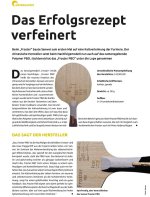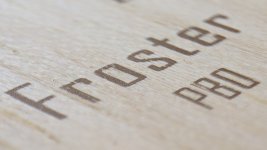This user has no status.
This user has no status.
Well-Known Member
Sanwei Froster EX-C PBO
Weight: 92 grams
Plies: 7 (Koto outer plies with ZLC composite layers)
Speed: Off++
Hardness: Very Stiff
This is the 2nd variant of the Sanwei Froster EX-C blade. Instead of the Kevlar layers, this was replaced by Zylon-Carbon composite materials after the outer layers. As expected the quality of this blade is on par with the previous EX-C Kevlar blade. Both the handles are the updated handles of the Sanwei blades which are much slenderer shape compared to the old version of the Sanwei Fextra blade. This blade is an alternative to many koto outer-zlc 2nd layer blade. The price is a bit steep when you see in the Sanwei website but I have seen several outlets selling this blade at a much lower price. Prices also vary from region to region. Overall quality build is top-notch, and finish is not in the level of usual Chinese-made blades. The blade has a beautiful fish-like scale surface of the koto outer plies. Please take note, the fish-like scale pattern of the blade surface does not affect play, e.i., does not make it faster or play better.
All I can say is that this is one fast blade. I only used the new version Sanwei Target National rubber with a more elastic and softer topsheet with a 38-degree sponge in testing the blade (both sides). I never expected the Froster PBO blade to be very fast the moment I had drills with this blade. It is surprisingly fast and powerful that it feels like you are using almost a TAMCA 5000 blade but with some amount of flex. So far, this is one of the fastest ZLC/PBO blade in the market. Even if you compare it with Japan and Euro brand of ZLC blades, the Froster EX-C PBO can hold up on its own when compared to the speeds of other well-known blades from other brands. It is safe to say that the speed is equal to Super ZLC blades and a bit faster than regular ZLC blades from other famous brands. Even with using non-Euro or Japanese rubbers on both sides, the blade is still very fast. Usually using Chinese rubbers on ZLC blades would greatly reduce the overall speed of the setup but in this case, I had to adjust a bit with the speed that I have to maintain short strokes on my forehand loops and drives with this blade. I felt it was too fast for me. Honestly this is not a blade even for intermediate-level players, the other version of the Froster has more control and can be used by intermediate-level players but the PBO version, this could easily pass as high-level blade. It needs very high-level of skills in order to maximize its use that I recommend this blade to players that if not they are national level players, they must be at least a high-level varsity players. It is very fast that even at middle distance if you use Chinese rubbers that are unboosted outside the factory, you only need somewhat a short swing. The blade’s crisp and overall stiff nature gives you outright an unnatural speed.
For spin, I do not see this blade as a pure looping blade but rather more on strokes that rely much on sponge compression during ball contact while maintaining some brush contact. This is a blade that is made for power shots so having a thin brush contact is not an optimal way of attacking with this blade. It is designed for doing heavy topspin attacks and then just follow up with counter loops away from the table. I would say this blade is not for gentle strokes. Although you can do effective drop shots and short pushes effectively, powerful flicks are much better to use with this blade. DO this mean that the blade is not an effective spinning blade? No, I do not think so but on the specific area where you rely more on the blades speed and power that slow spinny looping with this blade is not the way to go for attacking. If you want a slower and spinnier loops, the Froster EX-C Kevlar version will be the blade to use not the PBO version. The low arc with this blade is excellent in attacking but need skills in doing it effectively because of the lesser room for error. This is the difference between the Kevlar and PBO versions because the Kevlar version like its ALC equivalents in the market have a softer feel and have better contact and control with the ball since you can properly and easily spin the ball. With the PBO version, the ball repulses in the surface outright. I only suggest this blade for skilled players. If you are an intermediate player, I would suggest either using a soft sponge rubber probably around 45 degrees and below or any rubbers with 2.0mm thickness sponge. With this blade speed and power, you will not need max rubbers. Players who smash a lot will love this blade because you can hit through spins even with just short swings. Blockers will also love this since the passive blocks that you will be doing still packs a punch.
In conclusion, I highly recommend this blade to players who are sure of their skills to maximize attacking. This is a blade that you should not hold back in attacking and its speed and power will take care of your game. The PBO version and the Kevlar version are both blade with different play styles. You just need to make sure which blade is the right one for you.
Weight: 92 grams
Plies: 7 (Koto outer plies with ZLC composite layers)
Speed: Off++
Hardness: Very Stiff
This is the 2nd variant of the Sanwei Froster EX-C blade. Instead of the Kevlar layers, this was replaced by Zylon-Carbon composite materials after the outer layers. As expected the quality of this blade is on par with the previous EX-C Kevlar blade. Both the handles are the updated handles of the Sanwei blades which are much slenderer shape compared to the old version of the Sanwei Fextra blade. This blade is an alternative to many koto outer-zlc 2nd layer blade. The price is a bit steep when you see in the Sanwei website but I have seen several outlets selling this blade at a much lower price. Prices also vary from region to region. Overall quality build is top-notch, and finish is not in the level of usual Chinese-made blades. The blade has a beautiful fish-like scale surface of the koto outer plies. Please take note, the fish-like scale pattern of the blade surface does not affect play, e.i., does not make it faster or play better.
All I can say is that this is one fast blade. I only used the new version Sanwei Target National rubber with a more elastic and softer topsheet with a 38-degree sponge in testing the blade (both sides). I never expected the Froster PBO blade to be very fast the moment I had drills with this blade. It is surprisingly fast and powerful that it feels like you are using almost a TAMCA 5000 blade but with some amount of flex. So far, this is one of the fastest ZLC/PBO blade in the market. Even if you compare it with Japan and Euro brand of ZLC blades, the Froster EX-C PBO can hold up on its own when compared to the speeds of other well-known blades from other brands. It is safe to say that the speed is equal to Super ZLC blades and a bit faster than regular ZLC blades from other famous brands. Even with using non-Euro or Japanese rubbers on both sides, the blade is still very fast. Usually using Chinese rubbers on ZLC blades would greatly reduce the overall speed of the setup but in this case, I had to adjust a bit with the speed that I have to maintain short strokes on my forehand loops and drives with this blade. I felt it was too fast for me. Honestly this is not a blade even for intermediate-level players, the other version of the Froster has more control and can be used by intermediate-level players but the PBO version, this could easily pass as high-level blade. It needs very high-level of skills in order to maximize its use that I recommend this blade to players that if not they are national level players, they must be at least a high-level varsity players. It is very fast that even at middle distance if you use Chinese rubbers that are unboosted outside the factory, you only need somewhat a short swing. The blade’s crisp and overall stiff nature gives you outright an unnatural speed.
For spin, I do not see this blade as a pure looping blade but rather more on strokes that rely much on sponge compression during ball contact while maintaining some brush contact. This is a blade that is made for power shots so having a thin brush contact is not an optimal way of attacking with this blade. It is designed for doing heavy topspin attacks and then just follow up with counter loops away from the table. I would say this blade is not for gentle strokes. Although you can do effective drop shots and short pushes effectively, powerful flicks are much better to use with this blade. DO this mean that the blade is not an effective spinning blade? No, I do not think so but on the specific area where you rely more on the blades speed and power that slow spinny looping with this blade is not the way to go for attacking. If you want a slower and spinnier loops, the Froster EX-C Kevlar version will be the blade to use not the PBO version. The low arc with this blade is excellent in attacking but need skills in doing it effectively because of the lesser room for error. This is the difference between the Kevlar and PBO versions because the Kevlar version like its ALC equivalents in the market have a softer feel and have better contact and control with the ball since you can properly and easily spin the ball. With the PBO version, the ball repulses in the surface outright. I only suggest this blade for skilled players. If you are an intermediate player, I would suggest either using a soft sponge rubber probably around 45 degrees and below or any rubbers with 2.0mm thickness sponge. With this blade speed and power, you will not need max rubbers. Players who smash a lot will love this blade because you can hit through spins even with just short swings. Blockers will also love this since the passive blocks that you will be doing still packs a punch.
In conclusion, I highly recommend this blade to players who are sure of their skills to maximize attacking. This is a blade that you should not hold back in attacking and its speed and power will take care of your game. The PBO version and the Kevlar version are both blade with different play styles. You just need to make sure which blade is the right one for you.











